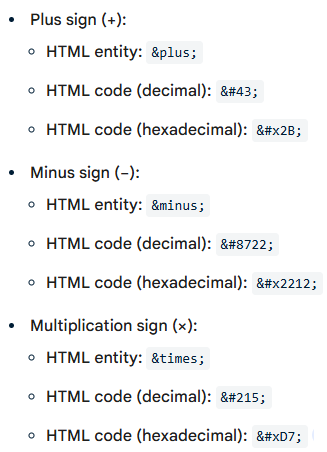Dichotomies, Trichotomies, Quadrichotomies
Dichonions, Trichonions, Quaternions
twos, threes, fours
2s, 3s, 4s
Trichotomists as of July, 19th, 2025
Let me note some triadic alternatives:
Yes, it is of need for those studying trichotomization to at least have some realization that there are:
- Triadic ensembles of enumeration which may involve a (repeated) single number such as 000, 111, 222, 333, 444, 555, 666, 777, 888, 999.
- Triadic ensembles featuring 2 of one number (such as 001) or use letters (ABC), symbols (+; - X) of which there are 3 commonly used methods:
- Triadic ensembles featuring three types of distinction:
- 24-7-365 (24 hours a day, 7 days a week, 365 days a year)
- arrayed as 2 numbers (24)- 1 number (7)- 3 numbers (365)
- 3 numbers (1-8-9) are missing (not including the zero)
- Triadic ensembles specific to regions and countries.
- e.g. The current number plate system in the UK was introduced in 2001 and is arranged in a set format of two letters, followed by two numbers, followed by three more letters.
- Triadic ensembles featuring mixtures of numbers, letters, symbols, and blanks before, in-between or afterwards.
- Triadic ensembles featuring singularly repeated or mixtures of sounds, sights, feeling, senses/sensations, etc...
- Triadic ensembles of singular or multiple experiences taken for granted, or that overwhelm, or which linger as a feeling, sense, shadow, nuance, ephemeral grasp (on the tip of one's tongue/consciousness).
- Triadic ensembles which are perceived as individual events among non-family members at the same time of day in different parts of a room, city, state, country, culture, time period, etc...
- Triadic ensembles that are misunderstood, misinterpreted, over/under/negligibly valued, or mislabeled.
- Triadic ensembles which repeat and are miscounted as more or less than an appearance of three.
- Triadic ensembles which are perceived as singular events but are actually triadic if one were able to remember a similar event having
taken place minutes before, hours before, days before, weeks before, months before, years before... or among different family members over
multiple generations who left no record of the event(s).
- Triadic events can take place over vast stretches of time. Here are some examples:
- Development of a triplet code in RNA/DNA.
- Development of RNA- DNA- Proteins.
- Development of Earth as the 3rd Planet.
- Development of the 3 Germ layers.
- Development of AMP- ADP- ATP.
- Development of 3 particle families.
- Development of 3 dimensions (or did the 3 just "poof" into existence?)
- Development of 3 strikes and you're out in baseall.
- Development of 3 point shots in basketball.
- Development of 3-colored traffic lights.
- Development of a 3rd World War conceptualization.
- Development of 3 basic rock formations (igneous, sedimentary, metamorphic).
- Development of Oil deposits from 3 main categories of living organisms: Producers, Consumers, and Decomposers.
- etc...
- Triadic events can take place over vast stretches of time. Here are some examples:
While some triadic ensembles are denoted as abbreviations, some have become iconic symbols of recurring usage such as the XYZ in graphing, the ABC's when referencing the English Alphabet, A2 + B2 = C2, and the 1st- 2nd- 3rd place positions in competitions. And in as much as the foregoing is meant as a sampling, in the present context I want to describe those writers who may speak of "threes" adjacent to one or another label (triads, ternary, treble, triune, etc...), and make mention of another pattern such as dualities, dichotomies, or patterns-of-four, alternatively labeled as groups of four, quaternions, foursomes, etc... However, the phrase "triadic ensemble" may not be known to them and nor may they be aware of others whose interest crosses paths with their own.
While some writers will focus explicitly on patterns-of-three in the context of displaying examples from one or multiple subjects, other writers will include some mention of patterns-of-two and/or and patterns-of-four, with those who think including a topic of singularity and/or plurality is for some reason in their mind a means to express an ego-laden suggestivity of being more intelligent and thus sperior. However, as it now stands, research in the field of trichotomization requires the researcher to have some modicum of knowledge about other patterns in context with whatever model of "triplicity" they are naming/labeling. And granted that some subjects are geared towards exclusive patterns and thus engage in some exclusionary model so as not to have to include other patterns, that's their preference... like playing chess, poker, checkers, or some other board game, large or small, such as engaging in solitare (for one person), or seesaw exercise (for two people), or some larger than two engagement of players.
No less, there is a need for establishing some semblance of a parameter which explains how the count of singularity, dichotomy, triplicity, quaternions, quintuplets, sextuplets, Septuplets, Octuplets, Nontuplets, Decatuplets, plurality, geometric figures, etc., fits together or not as cognitive variabilites of discussion. While you may notice one or another pattern, how does it fit in with the others in terms of recurrence and design? For example, just because we have a solar system of multiple planets does not mean this quantitative or qualitative multiplicity shows up with a dominant regularity. And you may say that there are billions of neurons in the brain or billions of cells in the body or billions of stars and there are billions of life forms; but how often does the billions category actually show up? And why, for those who would want to use the presence of "billions" as an attempted argument against dualities, triplicities, etc... why don't they include the categories of Trillions and Quadrillions? When such large enumerations may themselves be another type of triple category... why are they obsessed with naming only a single large quantity? In other words, it is rather fruitless to engage in an attempted discussion with the various personalized hypocrisies humanity engages in such as for example those who use the "god" variable as THE answer to all equations by wielding it as a shield, sword, or secreted lair to retreat to.
This present page also references three-patterned ideas from the distant past such as those described as mythological, legendary, religious, spiritual, metaphysical, superstition, magic, and esoteric... No less, we can not exclude examples from the more immediate present, though they may be termed cultural relics, fads, temporary or contemporary or pedestrian commercialisms, and those examples which might endure into some future time and place for the whole of humanity or some selective practice within a given group's orientation. With respect to past examples, very often we see those from mythology and some spirituality being named, which are commonly associated with what might be described as a metaphysic... like the hint of a possibility... similar to an attempt to imagine the physical presence of a guess, gesture, or question mark of possibility. This "at-the-tip-of-one's-tongue" or territorial edge of a current model of conceptualization when applied to the earliest development of a counting system, presents us with formulaic expressions of increasing quantities as ephemeral suppositions associated with some language equivalent "many, more, much, heap, bunch, pile..."
However, the word "other" has been used to describe a proposed category extending or thought to exist "beyond"... or at least adjacent to the three categories of Dumezilian Trifunctional ideology so as to capture... or at least pay some acknowledgement to nuances of perception being made by some research observations. Indeed, it is a proposal suggesting the question of "what lays beyond a given triad"? ... or at the very least, asks the question "is there something beyond the three?" And in some attempts, the approach is merely to whittle away at a proposed three structure, whereby one can assumes that by so doing, they have achieved something beyond... by way of disparagement. Elsewise one might be inclined to think that the proposed "3 in 1" model being used in the Christian Trinity ideology is sufficiently appropriate for application in other contexts where some 3 + 1 pattern is suggested to exist. Whether we name/label the "1" as other, four, plurality, or whatever, the underlying pattern of 3 and 1 or 3 and 2, or 3 + more, is given an intellectual existence worthy of consideration as a measurement we can count, even if we are unsure of what the count means or represents, and whether or not it represents someting different to different observers enabled to consciously perceive this currency of ideological exchange.
In terms of exploration, intellectual or otherwise, Mathematics denotes the "other" as Pure or Higher mathematics. In Art we see descriptions of Abstraction. In Music, one might describe some epiphanous pure note or ensemble expressed as a symphony (instead of describing it with a term such as calculus). In some circumstances you may come across the notion of going beyond the beyonded beyondedness. In religion you might hear the word Revelation. In Politics and Sociology one might use the word Revolution. In biology one might use the word evolution or mutation. No less, every subject, every interest of humanity has an attempted means of describing... of illustrating some notion of a next step, next generation, something other than that which has been considered. Yet, as we look at some of the so-called "four" patterns in biology, this "going" beyond a 3rd event typically expresses itself as being different from a previous three. We see it in physics, genetics, and multiple other venues of intellectual pursuit. Yet it has not been described as a counting system being used by Nature. Indeed, if Nature as we know it is in a primitive stage of development in a larger cosmological sense, then the patterns we humans perceive are but the fledgling efforts of a primitive counting system being developed. Whereas you may say 3 + 1 because you have come to appreciate distinctions, another may say "four", but neither view it as a value notation count such as ones-tens-hundreds... thousands. Our existence may be little more than an expressed lower number of a much more complex system of enumeration yet to come in ways the human mind, regardless of subject, can not fathom.
Here are some currencies of "four" that need to be reviewed and considered as a recurring 3 -to- 1 model or whatever language/symbolism/algorithm you care to use as a means of acknowledging that a distinction can be made and is a recurring cognitive pattern:
- Four horsemen of the Apocalypse: 3 represent (suffering) life, 1 represents death. (conquest, war, famine, and death).
- Four directions concept: 3 are separated from 1 by the word "and"... (North-South-East (and) West).
- 3 bears and 1 Goldilocks'
- 3 pigs and 1 wolf
- 3 fiddlers and 1 Old King Cole
- 3 real Musketeers (Athos, Porthos Aramis) and 1 wannabe (want to be): D'Artagnan
- 3 face cards and 1 Ace
- 3 persons in 1 godhead
- 3 engines in 1 space shuttle
- 3 typical football downs and 1 critical moment/last chance down
- 3 tires to be purchased to get 1 free
- 3 fingers to hold 1 pen/pencil/paintbrush
- 3 items in 1 fast-food combo meal
- 3 vending machine coins to 1 paper dollar or credit card
- 3 computer screen alternatives in 1 upper right corner (minimize- maximize- close)
- 3 names often applied to 1 person (in multiple cultures we see a 1st, middle, last name)
- 3 Olympic medalists stand together on 1 tiered podium
- Four amino acids of DNA/ RNA: 3 the same, 1 is different: Adenosine-Cystosine-Guanine + Thymine/Uracil.
- Four protein structures: Primary is bead-like, the other 3 are ribbon-shaped.
- Four tires on vehicles: the right (or left) front tire gets the most wear:
- In right-hand traffic countries like the US, the right front tire of a vehicle tends to wear out faster than the others due to the forces exerted during turns. This is because most cars have a front-engine, front-wheel drive (FWD) configuration, which puts more weight and force on the front tires, and right turns are generally tighter than left turns, further increasing wear on the right front tire, according to Jalopnik and Toyo Tires.
- Four human appendages: Either the left or right arm/hand gets used the most in multiple contexts.
-
Four stomach compartments of
Quadrupeds (only 1 is considered a true stomach):
- Rumen: This is the largest compartment and acts as a fermentation vat, housing billions of microbes (bacteria, protozoa, and fungi) that break down the plant material (cellulose) into usable nutrients, mainly volatile fatty acids (VFAs). The rumen also absorbs these VFAs, which are the cow's main energy source.
- Reticulum: Connected to the rumen, the reticulum has a honeycomb-like lining and helps in sorting the food particles. Smaller particles move forward, while larger ones are sent back to the rumen for further digestion and rumination (chewing of the cud).
- Omasum: This compartment has numerous folds of tissue resembling pages in a book, increasing its surface area. Its main function is to absorb water, electrolytes, and any remaining VFAs before the food moves to the next chamber.
- Abomasum: Known as the "true stomach," the abomasum is similar in function to the stomachs of non-ruminant animals. It secretes digestive enzymes and hydrochloric acid to further break down proteins and other nutrients, preparing them for absorption in the small intestine.
- Four seasons concept: 3 are separated from 1 by the word "and": Winter-Spring-Summer (and) Fall.
- Four fundamental forces: 3 are considered as related to the Standard Model, 1 force is not: Strong/Weak/Electromagnetic + Gravity.
- Four states of matter: 3 are contemporaneous to Earth, 1 is not: Solids-Liquids-Gases + Plasma.
- Four dimensions: 3 are spatial, 1 is not: length, width, height + time.
- Four Biblical gospels: 3 are idiosyncratic, 1 is idiosyncratic: Matthew, Mark, Luke are similar, John is not.
- Fourth year designation: Every year following three, is considered a Leap Year.
- Four Monkeys: 3 are commonly referenced in Western Culture, 1 is noted in Eastern Culture... Hear-Speak-See no evil + 1 do no evil.
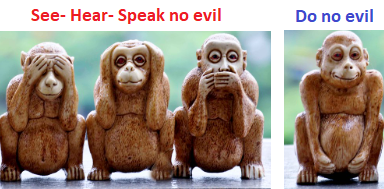
- 3 persons in 1 godhead: if three are separate entities then only together do they comprise the 1.
- Single head "monocep/unicep" muscles are most abundant, with others numerically termed as Bicep- Tricep- Quadricep
- On some occasions there are more than four heads (such as five or severn) to a muscle termed a supenumerary condition.
- 3 alternative body part references seldom put together as a triad:
- On some occasions there are more than four heads (such as five or severn) to a muscle termed a supenumerary condition.
Here is an example of a mathematical "four" you may or may not be familiar with. I used the internet query "3 forms of quadratic equations":
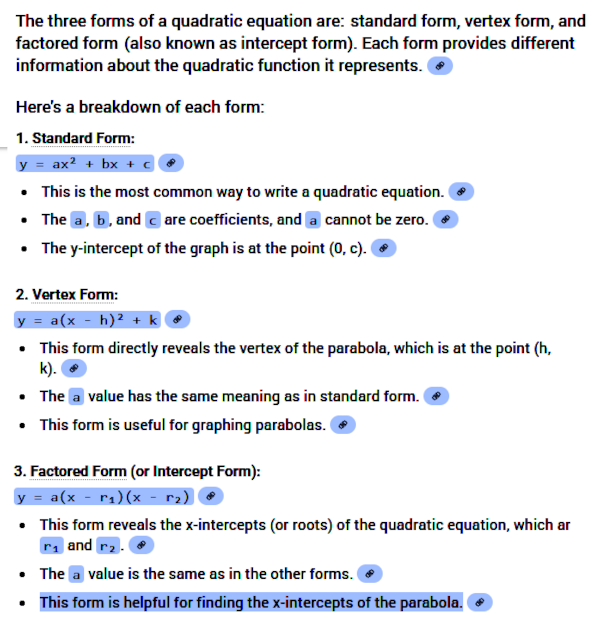
In some instances it is not a 3 + 1 pattern, but a 2 + 1 or 2 + 2 or 1 + 1 or expressed reversal. The point to be made is that we can sometimes recognize individual and collective differences even among presumed identical twins, triplets, quadruplets, etc... While you may recognize a pattern that no one else has, is the pattern seen as a distinction apart from or together with the other distinctions? In other words, don't get too comfortable resting on intellectualized laurels. In addition, from the examples of a presumed "four" quantity we can clearly see the existence of a 3 -to- 1 ratio in multiple instances. However, in cases of a presumed "five" or more quantity, the clearly marked tripartite referencing may be overlooked. For example, in the case for naming the quantity of Brain waves, the first examples is an easily verified 3 to 1 ratio and the example of Five brain waves following, also has a tripartite structure, though it is of need for me to categorize them since the reader may not have the experience to visually perform this on their own.
Brain wave counts and "Hertz" referencing... (Brain waves are patterns of electrical activity produced by the brain, and they are categorized based on their frequency, measured in Hertz (Hz). Each brainwave type is associated with different states of consciousness and mental activity.):
- Beta Waves (12-30 Hz); These brain waves are associated with alertness and wakefulness. They are most commonly observed in the frontal lobe of the brain.
- Alpha Waves (8-12 Hz); These brain waves are associated with relaxation and calmness. They are most commonly observed in the occipital lobe of the brain.
- Theta Waves (4-8 Hz); These brain waves are associated with meditation, creativity, and dreaming. They are most commonly observed in the temporal lobe of the brain.
- Delta Waves (0.5-4 Hz);– These brain waves are associated with deep sleep and unconsciousness. They are most commonly observed in the parietal and frontal lobes of the brain.
Here is an example of the five brain waves model, including the uncommonly referenced "infra-low" illustrated on the upcoming image after this table:
| Frequency band | Frequency | Brain states |
| Gamma (Γ) | >35 Hz | Concentration |
| Beta (Β) | 12–35 Hz | Anxiety dominant, active, external attention, relaxed |
| Alpha (&aspha;) | 8–12 Hz | Very relaxed, passive attention |
| Theta (Θ) | 4–8 Hz | Deeply relaxed, inward focused |
| Delta (Δ) | 0.5–4 Hz | Sleep |
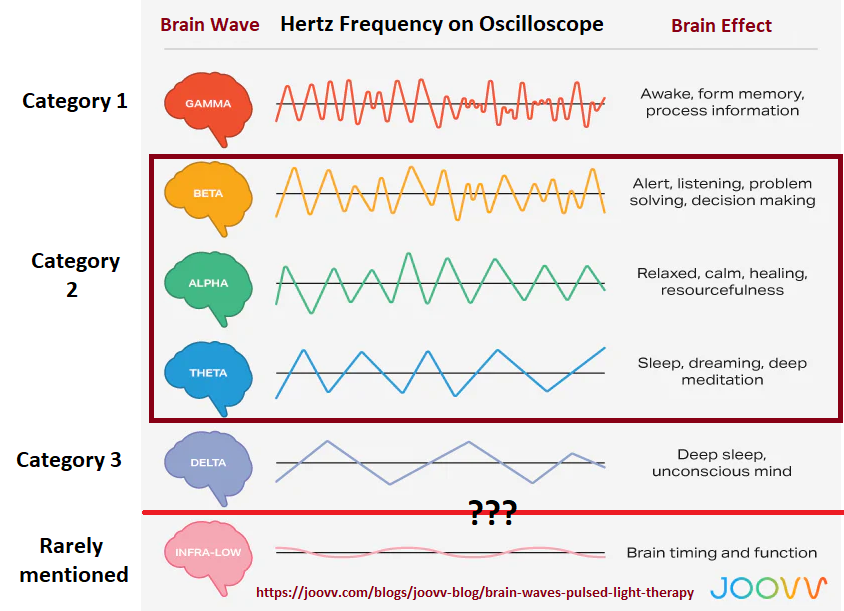
It is unfortunate that those who offer some "four" ideas model do not invest a bit more and come to recognize that what we may dealing with is not an actual 4 grouping, but a 3 + 1 ensemble, as if paying witness to an exercised cognitive count that extends the ones-tens-hundreds category into a thousands description, but that those thinking in terms of a "four" group do not then consider there exists a 3 + 2, 3 + 3... etc., where one group of three has the potential of being part of additional ensembles of three, though this is no guarantee one is sufficiently aware enough to make such distinctions. If one's consciousness has not evolved to this plane of exploration, then such a conceptualization of After Every Third will not make its debut on their present level/type of conscious perception of nuances, ephemeral valences, whispers, shadows, subtlety, flickerings, wistful meanderings, hints, etc., Such ideas are in oscillating murmuration, bubbled snowflake, concentric undertow of an explorative conscious, breadcrumb or broken twig or footprint indications, the territory to be described with such conventional labels as abstraction or metaphysics, or spirituality or even "way out there" just as one might think to describe humanity's earliest developments of a counting system by way of a simple one-to-one correspondence of pairing or as a spontaneously generated revelatory impression that may or may not overwhelm the one experience the leap, the punctuation of a cognitive construct... much in the manner one might presume the origination of words occurred... and I am reminded of the time when at a very young age I heard a whistle and was momentarily later startled to realize that my repeated efforts to learn how to whistle eventually manifested in such an expression I was not prepared for... since I was not consciously attending to the effort of whistling, and was more engaged in a haphazard, intermittent practice. I actually looked about me to see who had whistled, and upon finding no one nearby, a further whistling attempt produced the cognizant realization that I was the originator... to much delight.
While it is relatively easy for children today to learn how to count by way of mimicry and practiced recital; before th advent of a symbol, word or gesture to reference a quantity, which might well be described as a vague shadow... that when conveyed to one or more others, may have seemed a ghostly tale or a point of genius, witchcraft, or insanity. Indeed, how does a naive mind capturing the whisper of a relative revelation give expressions of the experience to their similarly naive social encounters who have not as yet cognitively progressed to a revelatory impression? The point is, unlike later efforts to create additional quantities after ten which is explained by math historians as a 10 + 1, 10 + 2/2 + 10 (or twelve), 3 + 10 (thir-teen), 4 + 10 (four-teen), 5 + 10 (fif-teen)... etc., the single digits from one to ten do not readily impress upon us a developmental progression of similarity. Hence, "2" does not look like nor sound like "1", but early compounded scratches on the ground do exhibit a geometric similarity by way of I stick, II sticks, III sticks, etc... But such an image of developmental cognition with respect to enumeration, particularly when including a reference to the later changes in the Roman numeral system with the usage of V, X, L, C before or after a stick figure "one" (I). And though my digressive take on the development of counting may not suit the tastes of some readers, here is a link describing the absence of the suffix "teen" being used for ll and 12, supposedly from a time when a base 12 was in use and played a later influence on successive gains in higher counting sequences: Why Do We Say "Eleven" and "Twelve" Instead Of "Oneteen" And "Twoteen"? by James Felton, edited by Holly Large.
For writers organizing perceptions into numerical representations such as dualities, triads, quaternions, etc.; speaking of any one or two of these is not itself a triad, if all three are viewed as an ensemble. In other words, if we accept the view that a pattern of 2-3-4 is a recurring cognitive triad, then an absence of any one or more of them is an incomplete or inconsistent triad, even if it was not the intent of the writer or speaker to explicitly discuss the ensemble because they were unaware of its existence. If you list examples of "threes" but also reference dualities but not quaternions, you are engaging in a count of two. Likewise for those who speak of threes and fours, but not twos. Unless you have some ulterior (let us say religious or commercial) purpose for speaking of one or two patterns, then it may be a momentary oversight or for some reason you think that some other recurring pattern does not hold as important a place for even a casual reference, just as I don't mention numerous patterns that a Numerologist might, because their intent is to reference a given recurrence as an especial attribute to lure someone into a close proximity of manipulative persuasion whereby the seller of such an idea creates a financial opportunity. Such opportunists as Numerologists and their pseudo-scientific ilk are, (not to mention many of those in the scientific, religious, eastern-philosophical, political, etc... realms); do not have to claim any conflict of interest in proposing their views. In short, all of us are biased... more so by some than others.
Collections of threes, like other collections, may be little more than a personal fad or a fad shared by others for one or another reason not at present adequately explained. Yet, usage and collections of triads (and other patterns) keep cropping up. I don't explicitly know why. I am simply making educated guesses. While you may claim it is due to some religious belief or some great Cosmological purpose, I am thinking more along the lines of a recurring influence in an environment which is incrementally deteriorating and may thus be cause for a decrease of increase in "threes" as a survival mechanism. We may not know until centuries from now. Yet, collectors today need to make an effort to preserve the lists in order that future researchers can be assisted in their efforts, with the knowledge and tools at their disposal and they are in a better position to decide whether or not the usage of triadic structure and contemplations thereof are wrought from superstition, stupidity or super-sanity.
Like a baseball game, while base hits are a common quality, that which lays beyond the three bases is a possibility, not a guarantee. You may hope for it, pray for it, or hold yourself in check so as not to commit oneself one way or another too deeply. The recognition of a "3" frequently presents us with a situation of guess work... of supposition or retreat to some former singular idea of plurality that may be defined holistically as a singularity or singularly as a multiplicity. Indeed, what will an accomplished 3-point shot in basketball reveal as an aftermath? Or a 3rd world war? Or that after the grouping of ones-tens-hundreds? Or that after a stated triad of gods?
Whereas one set of three can be followed by another set of three like that of place value notation, this does not mean to imply that another set of three is obligated to show up in a similar manner or at all It could the the case where a set of three is not followed at the same time and place or manner. A single item may follow or two items... all of which may exhibit a different value, image, sound, taste, or be intermittent over vast time periods and places. Instead of three followed by another three several times, there may be a single item only once, at a given moment. There need not be a ten thousands following a thousand... until sometime in the future, or that which you are now designating as a group of ones-tens-hundreds is actually a set of three having followed sometime later an earlier occurrence. While such a view might be preposterous to some, it needs to be considered and stated.
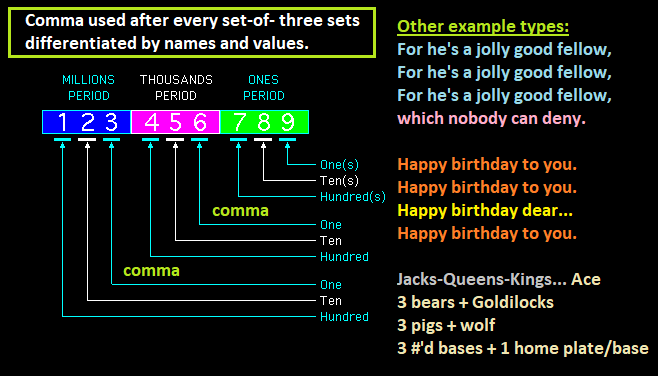
Initial Posting: Saturday, July 12th, 2025... 3:33 AM
Updated Posting: Saturday, July 19th, 2025... 7:44 AM
